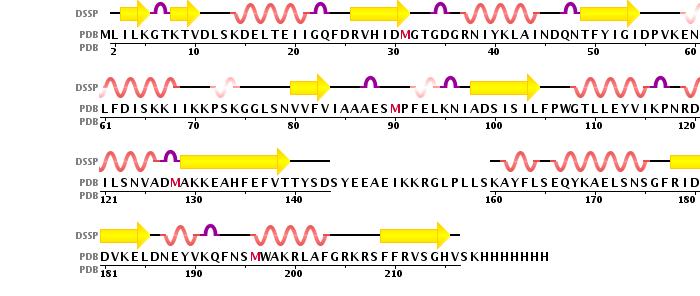User:Anika Zohra Yasin/Sandbox1 3pb3
From Proteopedia
| Line 19: | Line 19: | ||
'''3pb3''' is a 2 chain structure with a 225 amino acid base sequence. | '''3pb3''' is a 2 chain structure with a 225 amino acid base sequence. | ||
| - | |||
| - | |||
| - | [[Image:12345.jpg]] | ||
| - | |||
| - | |||
| - | |||
Each chain consists of 10 <scene name='User:Anika_Zohra_Yasin/Sandbox1_3pb3/Secondary_structure--alpha/2'>Alpha Helix</scene>es and 9 <scene name='User:Anika_Zohra_Yasin/Sandbox1_3pb3/Secondary_structure-beta/1'>Beta Sheet</scene>s. Specific amino acid residues D30, W107 and W197 are crucial to NpmA methyltransferase activity. '''D30''' facilitates cofactor binding by coordinating the carboxypropyl moeity through two water molecules. '''W107''' and '''W197''' stabilize the binding, since the target base is stacked between these two residues within the active site of NpmA. | Each chain consists of 10 <scene name='User:Anika_Zohra_Yasin/Sandbox1_3pb3/Secondary_structure--alpha/2'>Alpha Helix</scene>es and 9 <scene name='User:Anika_Zohra_Yasin/Sandbox1_3pb3/Secondary_structure-beta/1'>Beta Sheet</scene>s. Specific amino acid residues D30, W107 and W197 are crucial to NpmA methyltransferase activity. '''D30''' facilitates cofactor binding by coordinating the carboxypropyl moeity through two water molecules. '''W107''' and '''W197''' stabilize the binding, since the target base is stacked between these two residues within the active site of NpmA. | ||
==Sequence== | ==Sequence== | ||
| + | [[Image:12345.jpg]] | ||
* Ligand Information: '''S-ADENOSYL-L-HOMOCYSTEINE''' (SAH) | * Ligand Information: '''S-ADENOSYL-L-HOMOCYSTEINE''' (SAH) | ||
Revision as of 20:42, 24 April 2012
|
Contents |
Introduction
NpmA is a methyltransferase or a type of enzyme that methylates one nucleotide in bacterial ribosomes, that contains the structures 3p2e, 3p2i, 3p2k, 3pb3, and 3mte. specifically methylates on the 16S rRNA at the N1 position of A1408. This enzyme belongs to the Kanamycin apramycin methyltransferase (Kam) family. They help create resistance to aminoglycosides, which function as effective antibiotics against certain types of bacteria.
Bactericidal antibiotics are commonly used to treat diseases caused by gram-negative and gram-positive bacteria. Due to the indiscriminate and increased use, bacteria have evolved and formed resistance to these aminoglycoside antibiotics. The different forms of resistance created to these antibiotics include inactivation by alteration, mutation of the small ribosomal subunit to modify the target site of the antibiotic, or methylation at specific sites on the 16S rRNA to prevent the binding of the antibiotic to the ribosome.
The antibiotic binds in a tight pocket on the small subunit of the ribosome, disrupting the pairing of codons and anti-codons. A clinical isolate of E.Coli has been found to possess, 3pb3, an enzyme that adds methyl groups and modifies specific bases in their ribosome, making this pocket unable to fit the antibiotic.
Biological Source
- E. Coli
Image:250px-EscherichiaColi NIAID.jpg
Structure
3pb3 is a 2 chain structure with a 225 amino acid base sequence. Each chain consists of 10 es and 9 s. Specific amino acid residues D30, W107 and W197 are crucial to NpmA methyltransferase activity. D30 facilitates cofactor binding by coordinating the carboxypropyl moeity through two water molecules. W107 and W197 stabilize the binding, since the target base is stacked between these two residues within the active site of NpmA.
Sequence
- Ligand Information: S-ADENOSYL-L-HOMOCYSTEINE (SAH)
Function
- Methyltransferase Activity
3pb3 acts as a methyltransferase also known as methylase which adds a methyl group to specific bases in their ribosomes. At the N1 position of A1408 in the 16S rRNA, methylation occurs. Conserved residues D30, W107, and W197 create complexes with the ligands in order to facilitate this methylation.
- Antibiotic Resistance
Methylation at the N-1 position of A1408 by NpmA will disturb the formation of the hydrogen bond between the A site and aminoglycosides. This highly reduces the binding affinities of aminoglycosides to the target. Kanamycin and apramycin are aminoglycosides affected by this conformational change and since these antibiotics are unable to bind to the ribosomes, they are rendered ineffective.
Significance
Aminoglycosides are the primary agents used to combat life threatening infections caused by gram negative and gram positive bacteria. The ability of these bacteria to confer resistance to these drugs is of serious concern. Research into the method by which these bacteria create this resistance is necessary in order to develop inhibitors. The NpmA structure and knowledge of interactions with its substrate is the first step in developing specific inhibitors of the Kam family of methyltransferases. Once this is acheived, Aminoglycosides that were once rendered ineffective will be able to provide treatment for these infections.

